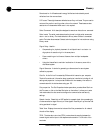
Glossary
152
Technical Services Group ~ 1-800-283-5936 (USA) ~ 1-801-974-3760
• Butterworth A crossover using a low-pass filter design characterized by a
maximally flat magnitude response. This results in no amplitude ripple in
the passband.
• Linkwitz-Riley A fourth-order crossover consisting of a cascaded second-
order Butterworth low-pass filter. Offers a vast improvement over the
Butterworth crossover and is the de facto standard for professional audio
active crossovers.
Cross point
The intersection between an input and an output in the routing matrix.
Cross point cells are colored according to input type.
Cross point attenuation
The process of attenuating audio level at the cross point.
Audio can be attenuated from 0 to 60dB.
Decay Rate (slow, medium, fast)
Determines how fast a channel gates off after
hold time expires. Default is medium.
Default meter
The input/output displayed on the front panel LED meter when a
input/output meter is not specifically selected elsewhere.
Delay
A setting in the Processing window. Delay calculates the amount of signal
delay (up to 250ms) based on the distance between audio source and audience and
the temperature.
Device ID
A number which identifies the unit when multiple units of the same
device type are connected in an E-bus network. Because up to eight XAP 400s may
be used in the same network, the device ID range is 0–7.
Device Type
A number which identifies the type of unit. For example, a XAP 400
is device type 7.
Dial Tone level
A setting in the Telco Configuration window which is used to adjust
the dial tone level. Level can be adjusted in 1dB steps to ±12dB.
DTMF dialing
DTMF or touch-tone dialing allows users to issue tones for access to
voice mail, pagers, etc.
DTMF level
A setting in the Telco Configuration window which is used to adjust
the level (volume) of the DTMF tones that are heard when dialing. Level can be
adjusted in 1dB steps to ±12dB.
DSP
Digital signal processor.
Echo Canceller Reference
The signal point which contains an electronic copy of
all signals which will be removed from the signal the mics pick up. This is always
the far-end audio and, optionally, local program material.


















